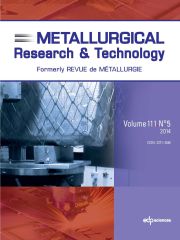Article contents
Lean duplex stainless steels – The role of molybdenum additionon pitting corrosion of concrete reinforcements
Published online by Cambridge University Press: 01 December 2011
Abstract
The use of stainless steels as concrete reinforcement is becoming increasingly popular incoastal and marine constructions in order to prevent corrosion induced by chloride ionspenetrating into the concrete. In these highly aggressive situations, the lean duplexstainless steels have been extensively employed due to their high mechanical and corrosionresistances. However, the influence of Mo addition on pitting corrosion resistance ofthese steels is not clearly understood in alkaline chloride conditions even if thiselement is widely associated to an increasing corrosion resistance in acidic and neutralenvironments. Therefore, understanding Mo mechanism on corrosion resistance in alkalinemedia is hence of major importance to the setting of optimized alloy composition. Thepresent work aims to study the effect of Mo addition on pitting corrosion properties oflean duplex stainless steels in alkaline environments (concrete). The results arediscussed with respect to the influence of Mo addition on pitting potential for twoindustrial duplex alloys (1.4362 and 1.4462) in several aggressive media mainly insynthetic, chlorinated and carbonated solution simulating concrete pore environments (pH10solution with carbonates and chlorides ions). In order to establish the real role of Moaddition on lean duplex corrosion and passivation properties, the corrosion behaviors oftwo specific laboratory lean duplex alloys, which the only difference between then is theamount of Mo (0 and 3% wt. Mo), are also studied. Furthermore, scanning electronicmicroscopy (SEM) was used to verify which phase of duplex microstructure (ferritic oraustenitic) is mostly susceptible to the pit nucleation in these corrosion conditions asthe role of Mo is probably different to each simple phase.
Keywords
- Type
- Research Article
- Information
- Copyright
- © EDP Sciences, 2011
References
- 5
- Cited by


